United Kingdom
2010
" 350th anniversary of The Royal
Society"
| Issue Date |
25.02.2010 |
| ID |
Michel: 2888-2897
Scott: Stanley Gibbons:
Yvert: UPU: GB025.10
Category: Co |
| Author |
Hat-trick Design |
| Stamps in set |
10: |
| Value |
1st class - Robert Boyle, Chemistry
1st class - Sir Isaac Newton, Optics
1st class - Benjamin Franklin, Electricity
1st class - Edward Jenner, Vaccination
1st class - Charles Babbage, Computing
1st class - Alfred Russel Wallace, Evolution
1st class - Joseph Lister, Antiseptic Surgery
1st class - Ernest Rutherford, Atomic Structure
1st class - Dorothy Hodgkin, Crystallography
1st class - Sir Nicholas Shackleton, Earth Sciences |
| Size (width x height) |
35x35mm |
| Layout |
stripe of 10 stamps 5x2 ; sheets of 30/60 |
| Products |
FDC x MC PP x1 |
| Paper |
|
| Perforation |
14.5 x 14.5 |
| Print Technique |
Lithography |
| Printed by |
Cartor Security Printing |
| Quantity |
|
| Issuing Authority |
Royal Mail of Great Britain |

This year is the 350th anniversary of The Royal Society, the worlds
oldest scientific academy in continuous existence. In celebration,
Royal Mail has today released ten 1st class commemoratives featuring
significant Royal Society figures whose portraits are paired with
dramatic and colourful imagery representing their achievements.
The brainstorming design was the idea of Hat-trick Design, responsible
for the interlocking jigsaw approach used for the
2009 Darwin stamps. But with
more than 1,400 Fellows and Foreign Members to choose from, how were
ten significant scientific figures to be selected?
Fittingly, it was The Royal Society itself which suggested the
solution: a case of basic division. It was agreed to split the 350-year
history into ten 35-year blocks in which it could be demonstrated how,
through the work of its Fellows, The Royal Society has had a major
impact on the World.
Royal Mail consulted with experts from the Society to determine the ten
Fellows, and due to the global nature of the organisation, non UK
citizens were included, such as one of the United States Founding
Fathers, Benjamin Franklin, and the New Zealand-born physicist Ernest
Rutherford.
Founded in 1660, The Royal Society celebrates its 350th Anniversary in
2010 and as the National Academy of Science of the UK and the
Commonwealth. It maintains its position at the forefront of inquiry and
discovery, and at the cutting edge of scientific progress.
The backbone of the society, which is a charitable body, is its
fellowship of the most eminent scientists of the day, and there are
currently more than 60 Nobel Laureates amongst the societys Fellows and
Foreign Members, of which there are more than 1,400. To this day,
Fellowship of The Royal Society is one the greatest honours that can be
conferred on any scientist.
The origins of the society lie in an invisible college of natural
philosophers who first met in the mid 1640s and were united by a common
desire to better understand the world and the universe through
observation and experimentation. This spirit of empirical observation
is encapsulated in the societys Latin motto, nullius in verba, which
can be roughly translated as take nobodys word for it.
 Robert
Boyle, Chemistry Robert
Boyle, Chemistry
Boyle (1627 1691) was a natural philosopher, chemist, physicist,
inventor, and gentleman scientist, also noted for his writings in
theology. He is best known for the formulation of Boyles Law. Although
his research and personal philosophy clearly has its roots in the
alchemical tradition, he is largely regarded today as the first modern
chemist, and therefore one of the founders of modern chemistry. Among
his works, The Sceptical Chymist is seen as a cornerstone book in the
field of chemistry. |
 Sir Isaac
Newton, Optics Sir Isaac
Newton, Optics
Newton (1643 1727) was an English physicist, mathematician, astronomer,
natural philosopher, alchemist, and theologian who is perceived and
considered by many as one of the most influential men in history. His
Philosophi Naturalis Principia Mathematica, published in 1687, is by
itself considered to be among the most influential books in the history
of science, laying the groundwork for most of classical mechanics. In
this work, Newton described universal gravitation and the three laws of
motion which dominated the scientific view of the physical universe for
the next three centuries. Newton was also president of The Royal
Society. The 300th anniversary of Principia Mathematica was marked by a
set of four stamps in 1987. |
 Benjamin
Franklin, Electricity Benjamin
Franklin, Electricity
Franklin (1706 1790) was one of the Founding Fathers of the United
States of America. A noted polymath, Franklin was a leading author and
printer, satirist, political theorist, politician, scientist, inventor,
civic activist, statesman, soldier, and diplomat. As a scientist, he
was a major figure in the Enlightenment and the history of physics for
his discoveries and theories regarding electricity. He was important in
the development of scientific experimentation and invented the
lightning rod, bifocals, the Franklin stove, a carriage odometer, and
the glass armonica.
In between his other achievements, the polymath Franklin found time to
examine fossils from Kentucky's Big Bone Lick. Stumped by what he
found, collector George Croghan sent specimens to Franklin, who
examined them in 1767. Franklin recognized some similarities to elephants, but also
some important differences. In fact, he was looking at mastodon remains.
He speculated that "perhaps the climates were differently placed from
what they are at present." Widespread acceptance of the notion of
extinction was decades away, and Charles
Darwin's proposal of natural selection lay nearly a
century in the future. Like Thomas
Jefferson, Franklin preferred migration to extinction in
explaining why the animals no longer lived in the same place. Although
Charles Darwin's hypothesis was a long way off, Franklin was friends
with the naturalist's grandfather, Erasmus
Darwin. |
 Alfred Russel Wallace,
Evolution Alfred Russel Wallace,
Evolution
Wallace (1823 1913) was a British naturalist, explorer, geographer,
anthropologist and biologist. He is best known for independently
proposing a theory of natural selection which prompted the joint
reading of his and Charles Darwins papers on evolution in 1858, and
spurred Darwin to publish his own theory the following year. Wallace
did extensive fieldwork, first in the Amazon River basin and then in
the Malay Archipelago, where he identified the Wallace Line that
divides the Indonesian archipelago into two distinct parts, one in
which animals closely related to those of Australia are common, and one
in which the species are largely of Asian origin. He was considered the
19th century's leading expert on the geographical distribution of
animal species and is sometimes called the "father of biogeography".
Wallace was one of the leading evolutionary thinkers of the 19th
century and made a number of other contributions to the development of
evolutionary theory besides being co-discoverer of natural selection.
These included the concept of warning colouration in animals, and the
Wallace effect, a hypothesis on how natural selection could contribute
to speciation by encouraging the development of barriers against
hybridization.
|
 Charles
Babbage, Computing Charles
Babbage, Computing
Babbage, (1791 1871) was an English mathematician, philosopher,
inventor and mechanical engineer who originated the concept of a
programmable computer. Babbage was pictured on a 22p Scientific
Achievements stamp in 1991. |
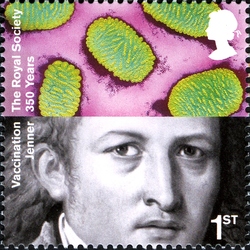 Edward
Jenner, Vaccination Edward
Jenner, Vaccination
Jenner (17 May 1749 26 January 1823) is widely credited as the pioneer
of smallpox vaccine, and is sometimes referred to as the Father of
Immunology. Jenner observed that milkmaids rarely got smallpox and
concluded that exposure to the bovine disease cowpox conferred immunity
a theory he tested and proved by injecting a child with pus from cowpox
blisters. Jenners development of the smallpox vaccine was marked by a
20p stamp in the Patients Tale Millenium set in March 1999. |
 Joseph
Lister, Antiseptic Surgery Joseph
Lister, Antiseptic Surgery
Lister, 1st Baron Lister, (1827 1912) was an English surgeon who
promoted the idea of sterile surgery while working at the Glasgow Royal
Infirmary. He successfully introduced carbolic acid (phenol) to
sterilize surgical instruments and to clean wounds, which led to
reduced post-operative infections and made surgery safer for patients.
The centenary of Listers discovery of Antispectic Surgery was marked by
two stamps issued in 1965. |
 Ernest
Rutherford, Atomic Structure Ernest
Rutherford, Atomic Structure
Rutherford, 1st Baron Rutherford of Nelson, (1871 1937) was a New
Zealand born chemist and physicist who became known as the father of
nuclear physics. He discovered that atoms have a small charged nucleus,
and thereby pioneered the Rutherford model (or planetary model, which
later evolved into the Bohr model or orbital model) of the atom,
through his discovery of Rutherford scattering with his gold foil
experiment. He was awarded the Nobel Prize in Chemistry in 1908. He is
widely credited as splitting the atom in 1917 and leading the first
experiment to split the nucleus in a controlled manner by two students
under his direction, John Cockcroft and Ernest Walton in 1932. He was
also president of The Royal Society. |
 Dorothy Hodgkin, Crystallography
Dorothy Hodgkin, Crystallography
The stamp marks the centenary of the birth of Dorothy Mary Hodgkin,
(1910 1994). She was a British chemist, credited with the development
of Protein crystallography. She advanced the technique of X-ray
crystallography, a method used to determine the three dimensional
structures of biomolecules. Hodgkin was also the first female Briton to
win a Nobel Prize. Hodgkin was also featured on a 20p Famous Women
stamp in 1998. |
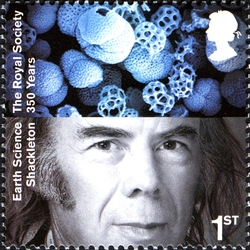 Sir Nicholas Shackleton,
Earth Sciences Sir Nicholas Shackleton,
Earth Sciences
Sir Nicholas John Shackleton was a British geologist and climatologist
who specialised in the Quaternary Period. He was the son of the
distinguished field geologist Robert Millner Shackleton and
great-nephew of the explorer Ernest Shackleton.
In 1967 Cambridge awarded him a PhD degree, for his thesis entitled
'The Measurement of Paleotemperatures in the Quaternary Era'.
Shackleton was a key figure in the field of palaeoceanography,
publishing over two hundred scientific papers. He was a pioneer in the
use of mass spectrometry to determine changes in climate as recorded in
the oxygen isotope composition of calcareous microfossils. He also
found evidence that the Earth's last magnetic field reversal was
780,000 years ago.
Shackleton became known, in 1976, with the publication of his paper,
with James Hays and John Imbrie, in Science entitled 'Products in the
Earth's orbit: Pacemaker of the ice ages'.Using ocean sediment cores,
the researchers demonstrated that oscillations in climate over the past
few million years could be correlated with variations in the orbital
and positional relationship between the Earth and the Sun |
Image credits: Robert Boyle drawing and portrait, crystallography
pattern The Royal Society; colour spectrum, smallpox vaccination,
Edward Jenner portrait, Ernest Rutherford portrait Science Photo
Library; Isaac Newton diagram and portrait, Charles Babbage diagram and
portrait, Dorothy Hodgkin portrait Science Museum/SSPL; lightning and
Benjamin Franklin portrait Getty Images; Alfred Russel Wallace portrait
National Portrait Gallery, London; oak tree photographed by Paul
Grundy; Joseph Lister portrait Wellcome Library, London; spray
photographed by John Ross; atom iStockphoto; micro-fossil image SEPM
Society for Sedimentary Geology, photographed by Dr Stanley A King;
Nicholas Shackleton portrait courtesy of Ingrid Pearson
Products
| FDC |
| The First Day Cover Envelope was designed
by Hat-trick Design. The filler card designed by Hat-trick Design
contains an extract from the Royal Society's charter together with
facsimile signatures of each of the individuals featured in the stamp
issue. |
The FDC features the Royal
Society FDC envelope together with the PSB Mixed Machin pane. |
|

|
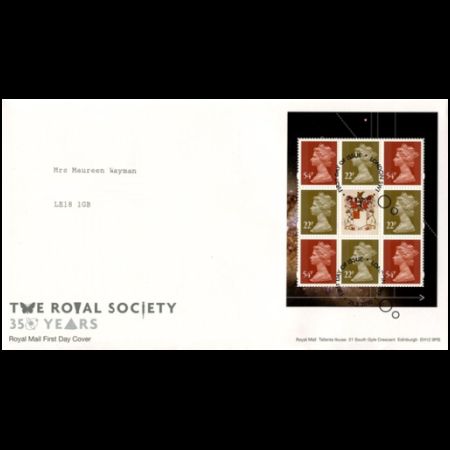
|
| Some personalized FDC |
Post Cards |
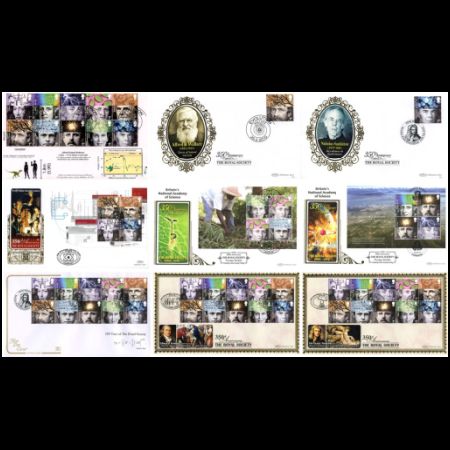
|
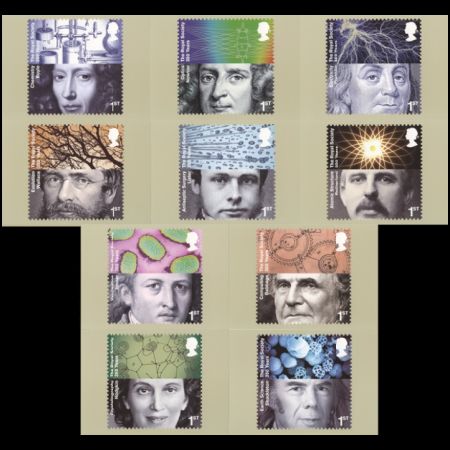 |
Prestige Booklet
Inside the PSB Eugene Byrne looks at the
history and role of The Royal Society, the book is lavishly illustrated with
objects from the society's archive.The book has been designed by
Russell Warren-Fisher and contains four stamp panes, one of four stamps
featuring two of Jenner and one each of Lister and Hodgkin, one of
four featuring Boyle, Babbage, Wallace and
Shackleton, another of four featuring Newton, Franklin and two of
Rutherford and finally a mixed Machin pane of 4 x 54p and 4 x 22p. |
Presentation Pack
The fully illustrated presentation pack
contains all ten of The Royal Society Stamps. Inside Eugene Byrne tells the story of each of
the individuals on the stamps. The pack was designed by Hat-trick Design and printed by Walsall
Security Printers |
 |
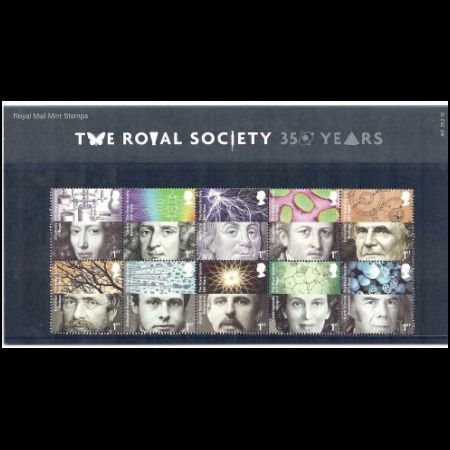 |
| |
| |
Special postmarks announced
for the Day of Issue.
Official post marks.
|
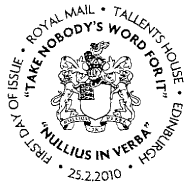
|

|

|
|
Ref FD1007
Philatelic Bureau Official Postmark (RS Coat of Arms)
|
Ref FD1008
London SW1, Bacup, Official Postmark
|
Ref FD1008NP
London SW1 Official non-pictorial Postmark
|
Another
(private) post marks
|

|

|

|
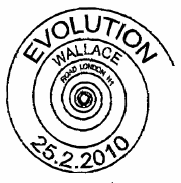
|
|
Ref L11619 Spring Stampex The Royal Society First Day of
Issue, London N1
|
Ref L11629 Celebrating 350 Years of Excellence in
Science The Royal Society, London SW1 |
Ref L11634 - London SW1
|
Ref L11639 - Evolution Wallace Road London W1
|
|

|

|

|

|
|
Ref L11630 - Carlton House Terrace, London SW1
|
Ref L11631 - Cambridge
|
Ref L11632 Gresham Street, London EC2
|
Ref L11633 - Hyde Park Corner, London SW1
|
|
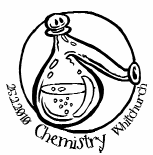
|

|

|

|
|
Ref L11635 Chemistry, Whitchurch
|
Ref L11636 - Cambridge
|
Ref M11644 Newton Road, Birmingham
|
Ref L11640 London SW1 - "If I have seen further it is by
standing on the shoulders of Giants" - Isaac Newton.
|
References:
Royal
Mail of Great Britain
Norvic
Philatelics
BFDC
Strange science
Wikipedia
Presentation
Pack
Latest
update 27.12.2017
Any feedback, comments or even complaints
are welcome: [email protected] (you
can email me on ENglish, DEutsch, or RUssian)
































